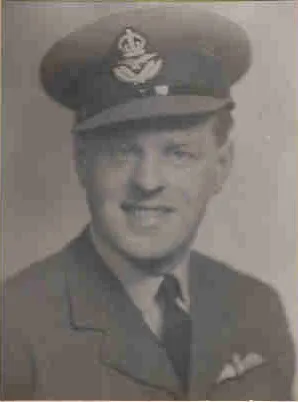Dorrell, Matthew
Killed in Action 1944-11-02


Birth Date: 1923-October-06
Born: Bulyea, Saskatchewan
Son of Matthew and Annie M Dorrell, of Bulyea, Saskatchewan. Brother of Joesph, James, Clarence, Beatrice, and Selina.
Home: Bulyea, Saskatchewan
Enlistment: Winnipeg, Manitoba
Enlistment Date: 1941-12-12
Service
RCAF
Unit
428 (B) Sqn- Squadron
Usque Ad Finem To the Very End
Base
RAF Middleton St George
Rank
Pilot Officer
Position
Sergeant
Service Numbers
C/90844
Prev: R/147377
Home
 Bulyea, Saskatchewan
Bulyea, Saskatchewan
Target
 Dusseldorf Germany
Dusseldorf Germany
First Burial
 Nordrhein, Westfalen, Germany, near crash site
Nordrhein, Westfalen, Germany, near crash site
428 Ghost Squadron (Usque Ad Finem) RAF Middleton St George. Lancaster BX aircraft KB 782 NA-H was shot down by a night fighter during an operation over Dusseldorf, Germany. The Lancaster crashed at Solingen, Germany with the loss of the entire crew
Pilot Officer M Dorrell (RCAF) was killed in action
Lancaster KB782
Avro Lancaster

Canadian Warplane Heritage Museum
The Avro Lancaster is a British Second World War heavy bomber. It was designed and manufactured by Avro as a contemporary of the Handley Page Halifax, both bombers having been developed to the same specification, as well as the Short Stirling, all three aircraft being four-engined heavy bombers adopted by the Royal Air Force (RAF) during the same wartime era.
The Lancaster has its origins in the twin-engine Avro Manchester which had been developed during the late 1930s in response to the Air Ministry Specification P.13/36 for a capable medium bomber for "world-wide use". Originally developed as an evolution of the Manchester (which had proved troublesome in service and was retired in 1942), the Lancaster was designed by Roy Chadwick and powered by four Rolls-Royce Merlins and in one version, Bristol Hercules engines. It first saw service with RAF Bomber Command in 1942 and as the strategic bombing offensive over Europe gathered momentum, it was the main aircraft for the night-time bombing campaigns that followed. As increasing numbers of the type were produced, it became the principal heavy bomber used by the RAF, the Royal Canadian Air Force (RCAF) and squadrons from other Commonwealth and European countries serving within the RAF, overshadowing the Halifax and Stirling. Wikipedia
428 (B) Sqn Usque Ad Finem ("Ghost")
History of the Squadron during World War II (Aircraft: Wellington III, X, Halifax V, II, Lancaster X)

No 428 Squadron was the ninth long-range heavy bomber squadron and the 26th RCAF squadron formed overseas during the Second World War. It was formed at RAF Dalton in Yorkshire, England on November 7, 1942. The squadron was initially assigned to No. 4 Group RAF Bomber Command. With the creation of No. 6 Group RCAF, the squadron was reallocated on January 1, 1943 operating with it until April 25, 1945.
The squadron was originally equipped with Vickers Wellington Mk III and X, and its first operational mission was on January 26–27, 1943, when five Wellingtons bombed the U-Boat base at Lorient in Brittany, on the Bay of Biscay. In the early part of June 1943, the squadron moved to RAF Middleton St. George, Durham where it remained for the remainder of the war. Around this time the squadron was converted to Handley Page Halifaxes (Mk Vs, and later supplemented by Mk II Series IIA). In January 1944, Halifax bombers from No. 428 Squadron participated in the first high-level mining raid "Gardening", when mines were dropped by parachute from 15,000 feet (4,570 m) over Brest on 4/5 Jan and Saint-Nazaire on 6/7 Jan 1944. The squadron flew its last sortie with the Halifax on June 12, 1944 then converted to the Canadian-built Avro Lancaster Mk X, the first sortie taking place on June 14, 1944.
For the final phase of the air campaign against Germany, the squadron took part in day and night raids, with its last operational sortie taking place on April 25, 1945, when 15 Lancasters bombed anti-aircraft gun batteries defending the mouth of the Weser, on the Frisian Island of Wangerooge. The squadron remained in service in the United Kingdom until the end of May 1945, then flew to Yarmouth, Nova Scotia . The squadron was intended to be part of the "Tiger Force" to carry on the war against Japan, but the Japanese surrender led to the disbandment of the force. The squadron was therefore disbanded at Yarmouth in September 1945.
In the course of WWII operations, the squadron flew 283 missions involving 3467 individual sorties. 84 aircraft were lost and a total of 9378 tons of bombs were dropped. the aircrew earned 2 DSO's, 71 DFC's, 2 CGM's and 6 DFM's. Battle Honours were: English Channel and North Sea 1943-44, Baltic 1944, Fortress Europe 1943-44, France and Germany 1944-45, Biscay Ports 1943-44, Ruhr 1943-45, Berlin 1943-44, German Ports 1943-45, Normandy 1944, Rhine, Biscay 1943-44. Wikipedia, Kostenuk and Griffin
Squadron History (Bomber Command Museum PDF)
Maps for Movements of 428 Squadron 1942-45

428 Squadron History Summary 1942-45

History of the Squadron Post-WWII (Aircraft: Canuck)
The squadron was re-activated as the fifth Avro Canada CF-100 Canuck equipped squadron, on June 21, 1954, at RCAF Station Uplands as 428 All-Weather (Fighter) Squadron. It was re-activated, as one of nine Canadian based RCAF squadrons, to be operating under the new RCAF Air Defence Command, protecting North American airspace from Soviet intruders and long range bombers. The squadron was finally disbanded on 1 June 1961.
 Canadian Virtual War Memorial
Canadian Virtual War Memorial






 Lancaster Bomber
Lancaster Bomber Wikipedia
Wikipedia Harold A Skaarup Web Page
Harold A Skaarup Web Page